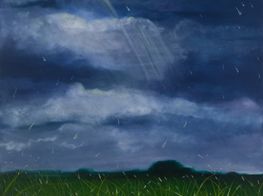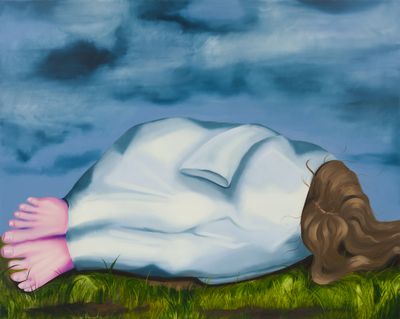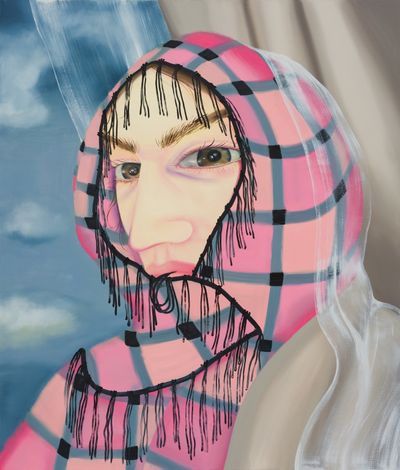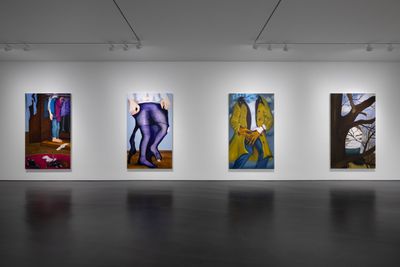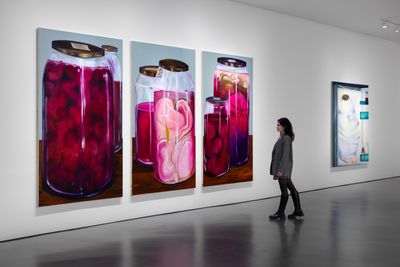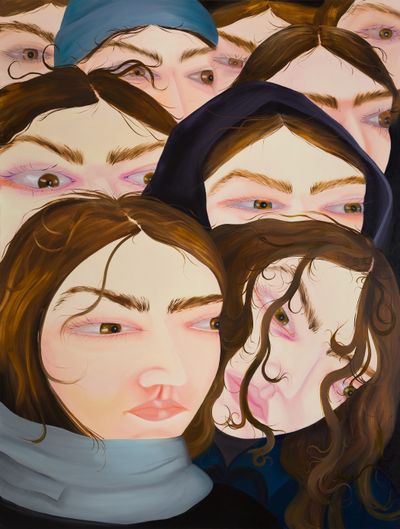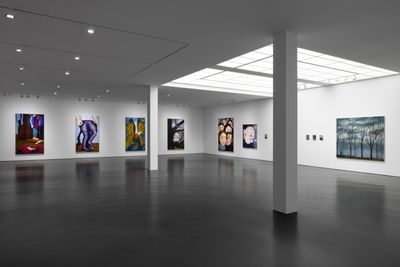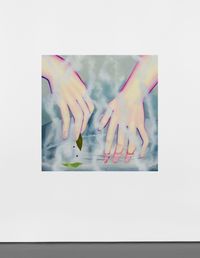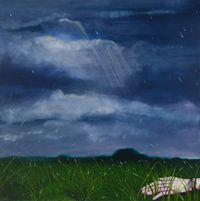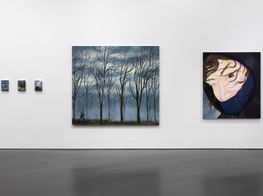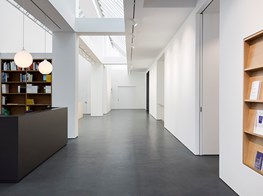Karolina Jabłońska on Invisibility and Painting
Sponsored | Esther Schipper
Portrait of Karolina Jabłońska. Photo: © Mateusz Torbus.
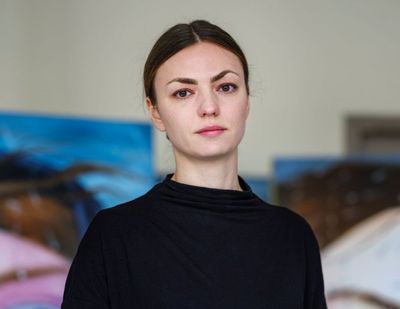
Portrait of Karolina Jabłońska. Photo: © Mateusz Torbus.
Titled after Kate Bush's 2005 song 'How to Be Invisible', Karolina Jabłońska's first solo exhibition with Esther Schipper Berlin probes into strategies for becoming invisible and, simultaneously, the paradoxical desire to be visible.
Jabłońska's oil painting depict young women painted after the artist's own image, with large, brown eyes, defined eyebrows, pale skin, and dark brown hair. Often sculpted with pink or purplish edges, the figures have an unsettling, glowing effect that intensifies their gestures, whether they cry, scream, or stare into the distance—a tactic Jabłońska deploys to counter the glamorised stereotypes of women in the media. 'My women are emotionally unstable,' she told Metal magazine.
In Jabłońska's new body of paintings from 2023, her protagonists devise methods to become invisible. How to be invisible shows a woman lying on the grass, curled into a ball within her white t-shirt, to leave only her pink feet and hair visible. The scene summarises the knotty nature of the desire for invisibility: even as Jabłońska's characters try to disappear, they still wish to be seen.
The paradox is also apparent in the portrait, Cozy blanket. A young woman has a pink tartan blanket around her head, framed by two additional layers—curtains, one transparent and the other an opaque grey—while fixing her gaze directly at the viewer.
Red preserves, a triptych of pickle jars with one containing a woman's severed head, is perhaps the most chilling image of the group. The containers are massive, with several scaling the length of the canvases at over two metres high. Painted in hues from soft pinks to murky magentas, the canvases evoke a sinister version of hide-and-seek.
Other paintings recall the absurd impulses of childhood that inevitably leave behind traces of the physical body. In Inside the wardrobe, for instance, items of clothing on the floor lead the eye towards a figure standing among the garments on a clothes rack. Leaves reveals not a person, but a bright pink glove amid a pile of dull yellow and brown leaves that betray the whereabouts of its owner.
The tight framing of faces, bodies, and objects in Jabłońska's paintings can be traced to the mid-2010s when she was studying at the Academy of Fine Arts in Kraków, be it in the gruesome Self portrait without head or in Girl in a white dress (both 2015), where disembodied hands grab at a woman.
At the Academy, Jabłońska met Tomasz Kręcicki and Cyryl Polaczek, with whom she founded the artist group Potencja [Potency] in 2012, as well as an artist-run space of the same name in Kraków. All the while, Jabłońska continued to develop her depictions of women, performing ordinary but impassioned activities of eating, running, and dancing.
Jabłońska has also channelled intense bodily sensations through paintings revolving around cold and heat. Snow rubdown (2022) is a startling work in which a pair of hands, tinged with an unnatural blue, rub snow over a woman's face. Her paintings of boiling pots are even more agonising for the extremity of the actions they describe, where bare hands are plunged into a boiling pot (Putting hands in the soup, 2022), while a gloved hand holds a woman's head in hot soup (Boiling head, 2023).
In the following conversation, Jabłońska speaks about painting entrapment, creating a metaphorical 'frame' for her works, and the difficulty of staying away from her studio.
SPCould you speak about your new exhibition at Esther Schipper and the Kate Bush song that gave it its title?
KJWhen I got the news that I was going to have a solo exhibition at Esther Schipper gallery, I had already finished the painting with a figure wrapped in a white t-shirt lying on the ground. That is why, at the end I gave that work the same title as the exhibition, How to be invisible, to highlight that it was created first. This painting is a continuation of a story I have been telling for some time now. I took it as a point of departure to create the rest of the exhibition, and ideas for the next works had been coming to me spontaneously and intuitively.
The concept for the show came to me a little bit later, when the cover of a book in a London bookstore caught my attention. It was a book of poems by Kate Bush titled How to be Invisible. I knew the song, but it was actually the cover of the book that had the biggest influence on me. The title was embossed on the cover. Thus, it was both visible but invisible as well. I immediately knew it would be the perfect title for my exhibition. It captures this longing to disappear, to calm down in peace, to isolate oneself from all the struggles of everyday life, which is present in my art. On the other hand, subversively, there is also a desire to be noticed, to be heard, to be as visible as possible—so typical for artists because, as I understand it, visibility is a big part of being an artist and that's what you're aiming for.
There is also another song by Kate Bush that intuitively became an inspiration for me, titled 'Breathing'. She wrote it during the Cold War, when the threat of nuclear war was omnipresent, and this is what this song is talking about: the constant fear that breathing—the thing necessary for survival—won't be possible anymore, and a fear for our loved ones. I don't want to compare these situations, but I feel some similarities between the fears in that song and the fears of my generation. In my paintings, I try to talk about this perpetual stress—concerning possible wars, refugee crises, or climate catastrophes, accompanied by the equally constant uncertainty about which information is true and which is false. At the same time, we need simplicity, we need breathing and calm. So I paint entrapment, hiding figures, oppression. I also paint landscapes, a figure trying to blend in with the surroundings and becoming part of the landscape.
SPHow did the works in the exhibition develop? On one hand, there are thematic parallels with the paintings that appeared in your solo exhibition Cold (2022) at Raster Gallery in Warsaw, which featured paintings of wardrobes, faces wrapped in scarves, and bodies that are seemingly hiding or stuck in clothing. Perhaps there is a relationship between visibility and invisibility, as well as coldness?
KJI never create my exhibitions as a closed project. I don't prepare works specifically for specific occasions. I just paint every day, and one painting develops out of another. When I know I have an exhibition coming soon, I need to focus and create a kind of frame for a group of works, but I almost never paint on a set theme. It is more like I catch the idea, take it out from the paintings and then it can become the 'frame'.
Some of the images in the current exhibition may resemble paintings from 2022 which was, after all, not so long ago. This is something I like to do: to link my exhibitions and also particular pieces with each other to give an impression of the continuation of the story. This is how I want my art to be received—as an ongoing story, and each project or exhibition is a chapter of it.
Certainly, there is a relationship between visibility and invisibility, as well as coldness and heat. These threads intertwine in my art often and I still haven't said goodbye to the theme of heat and cold, which came to me on the occasion of the exhibition Cold at Raster. I'm not done with invisibility and visibility either.
SPWhat is the most difficult part of the creative process for you?
KJThe most difficult part of the process for me is staying away from the studio, waiting for inspiration, relaxing and having fun. I consider my entire life as a part of the process. Ideas for new paintings come during everyday activities, such as reading, running, and talking with friends, and spring unconsciously. I am impatient—I don't like to wait for anything too long, and even if I spend my time on something nice, I keep checking the time. For a long time, I was considering time spent outside the studio as wasted time.
The most exciting part of my job is finding revelations among the books I read, interesting moments or sentences which stimulate me to come up with images and stories. The easiest part for me is to actually paint; it is also the most rewarding moment. I love the movement and the change of the blank canvas into a colourful image. I'm not saying it's always easy—I fail quite often and have to destroy paintings—but if it goes well, it's a really great feeling.
SPReading is an important source of inspiration and reflection for you. What interests you at the moment?
KJRecently I realised, I had been reading mostly female authors last year. I discovered for myself the literature of Joan Didion, Lidia Yuknavitch, or Deborah Levy. I love how they all can go deep inside themselves, extract the most precious parts, mix it with different sources of inspiration, and bring it to reality in a new form. I'm amazed how strong a trigger for creating visual language writing can be. It is not that I paint what I read, but even a short description of the landscape or character outline can be a release for a strong visual story about totally different things to what a particular book was about.
My favourite and the most emotionally intense book of last year was The Chronology of Water [2011] by Lidia Yuknavitch. Today I finished The Vulnerables [2023] by Sigrid Nunez. The story takes place during the pandemic in New York and it is somehow nice to see the lockdown experience, that was shared by most people all over the word, from a far-off perspective. The book plays with the convention of autofiction which recently has become an interesting subject for me.
SPCould you tell me about your work with Potencja? What place does collaboration have in your practice?
KJI met Tomasz in 2010 on the first day at the Academy of Fine Arts in Kraków. We became friends, then a couple, and also to some extent competitors (I mean, we gave ourselves a positive thrill). We hadn't been surrounded by any kind of art or creative people before—we're not from artistic families so everything in the first year of Academy was new and exciting to us.
Tomasz became friends with Cyryl who was much more experienced in painting, and he impressed us. I had been hanging around them and trying to keep up. We started doing things together as funny artworks; then exhibitions, movies, music—mostly for fun. After a time we started to treat all of it more seriously and invited other artists to cooperate with us. We rented a space in Kraków to make exhibitions more regularly. Not long ago we published a book, Potency - The Book of Symbols, in collaboration with the gallery, BWA Zielona Góra.
Cooperating with Tomasz and Cyryl was the most precious artistic experience I have ever had. I learned from those guys a lot; as artists we grew together. When you are in a group you can do a lot more things than by yourself. You gain confidence, but also the responsibility is spread across more people, so you can go nuts without thinking much about the consequences. For some time, we haven't done anything together—we focused more on our own careers and lives. Maybe also some kind of collective energy had run out. Anyway, the carefreeness and confidence of the group was something that I really needed at that time and I can't be more grateful that I was a part of the Potencja team.
SPYou have two shows coming up—a solo exhibition at the State Gallery of Art (PGS) in Sopot, and a group presentation at Dallas Contemporary in Texas.
KJI am intensively working on the Sopot show, and the book that will be published on that occasion.
The exhibition will be built around an auto-theoretical and auto-fictional impulse. I painted a gigantic sketchbook, with ideas for possible paintings or ones that already exist. The sketchbook painting is taken as a starting point for the entire exhibition. I'm working on this show with a great curator, Wojciech Szymański. It is an exciting process, and we're also creating a book. The graphic designer is Agata Biskup with whom I worked with on my previous book.
Before the Sopot solo show, there is a thrilling group show, Who's afraid of cartoony figuration?, curated by Alison Gingeras at Dallas Contemporary. It will be my first museum presentation in the U.S. My series of kitchen paintings will be presented among art by Sally Saul, Tabboo!, and Umar Rashid. In paintings as Apron or Pickles I allegorically depict the conflict between traditional gender expectations and the feminist agency of my generation. —[O]

